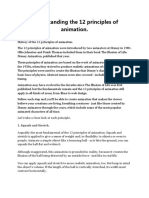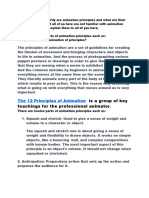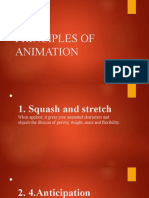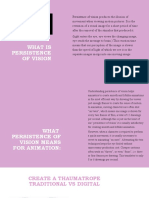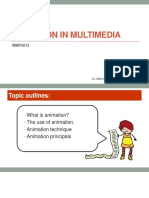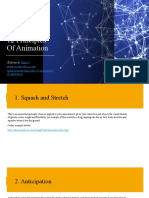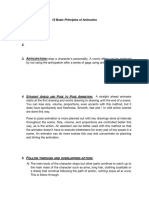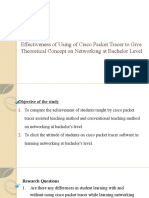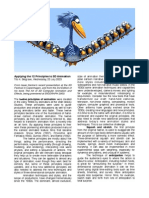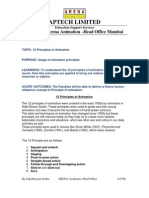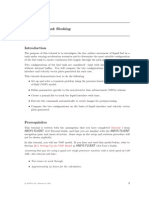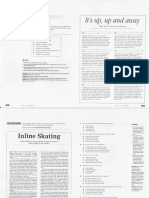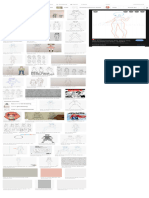Introduction to Animation:
It is the act of making something alive. It
is the art of creating moving images via
the use of computers. In animation a
series of images rapidly changed to create
an illusion of movement. A person who
creates animations is called animator
Animation includes all the visual changes
on screen of the devices. These are:
- Change of shape
- Change in size
- Change in color
- Change in structure
� - Change in angle
Types of animation:
1. Cel animation: A traditional form of
animation used in production of cartoons
of animated movies where each frame of
the scene is drawn by hand. A full length
feature film produced using cel animation
would require a million or more drawings
to complete.
2. Computer animation: It is a subset of
both computer graphics and animation
technologies. It is the creation of moving
images (animation) using computer
technology.
3. Kinematics: It is the study of
movement and motion of structures that
have joints like walking man. Such type of
animation are usually used in areas like
mechanics, etc.
� Application areas of animation:
1. Education and training
2. Entertainment
3. Computer Aided Design (CAD)
4. Advertising
5. Presentation
6. Video games
7. Medical training
12 Principle of animation
These basic principles of animation, first
outlined by Disney animators Ollie
Johnston and Frank Thomas in their book
"The Illusion of Life: Disney Animation,"
form the foundation for creating
compelling and believable animated
sequences. Let's briefly elaborate on each
principle:
1. Squash and Stretch: This principle adds
weight and flexibility to objects, making
their movements appear more dynamic
and organic. It's especially important for
conveying the sense of impact or
momentum in animations.
�2. Anticipation: By preparing the audience
for an upcoming action, anticipation helps
to make movements more believable and
engaging. It can involve subtle
movements or changes in expression that
build anticipation for the main action.
3. Staging: Effective staging directs the
viewer's attention to the most important
elements of the scene, ensuring that the
message or story is conveyed clearly. It
involves careful composition, framing, and
timing of elements within the animation.
4. Straight Ahead Action and Pose-to-
Pose: These are two different approaches
to creating animation. Straight ahead
action involves drawing each frame
sequentially, starting from the beginning
and working towards the end. Pose-to-
pose animation involves planning key
poses first and then filling in the
intervening frames.
5. Follow Through and Overlapping
Action: These principles add realism to
movements by incorporating the natural
tendency of objects to continue moving
after the main action has ceased. Different
parts of a character's body may also move
� at different rates, creating a more fluid
and lifelike motion.
6. Slow In and Slow Out: Objects in motion
typically accelerate and decelerate
gradually, rather than moving at a
constant speed. This principle helps to
create smoother, more natural-looking
animations.
7. Arcs: Most natural movements follow
curved paths rather than straight lines. By
animating objects along arcs, animators
can create more realistic and visually
appealing motion.
8. Secondary Action: Secondary actions
complement the main action and add
depth and richness to the animation. They
can include facial expressions, gestures,
or movements that enhance the
character's personality or mood.
9. Timing: The speed of actions should be
appropriate for the situation and convey
the intended mood or emotion. Timing can
vary depending on factors such as the
weight of objects, the force of an action,
and the desired effect on the audience.
10. Exaggeration: Exaggerating
movements can make animations more
� expressive and engaging. It's a key
technique for emphasizing emotions,
actions, or characteristics and adding
visual interest to the animation.
11. Solid Drawing: This principle involves
creating the illusion of three-dimensional
objects in two-dimensional animation. It
requires a solid understanding of form,
anatomy, and perspective to give
characters and objects depth and volume.
12. Appeal: Characters and actions should
be visually appealing and interesting to
the audience. Appeal can be achieved
through appealing character designs,
expressive movements, and engaging
storytelling.
Animation Function:
1. Morphing: It is used to transform object
shape from one form to another. It is one of
the most complicated transformations. This
function is commonly used in movies,
cartoons, advertisement and computer
games.
2. Tweening:It is the short form of
inbetweening. It is the process of
generating intermediate frames between
�initial and last final images .This function is
popular in film industry.






